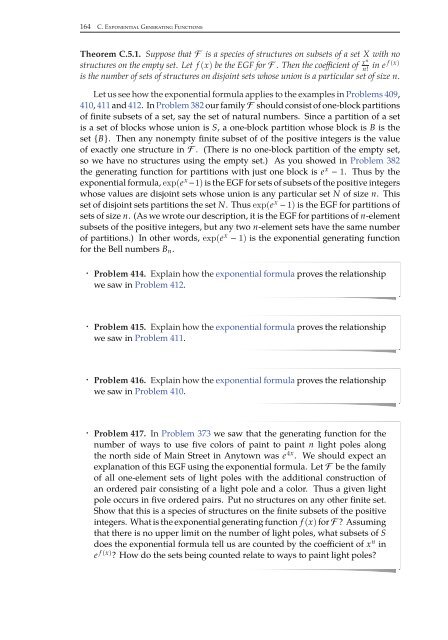Combinatorics Through Guided Discovery, 2004a
Combinatorics Through Guided Discovery, 2004a
Combinatorics Through Guided Discovery, 2004a
You also want an ePaper? Increase the reach of your titles
YUMPU automatically turns print PDFs into web optimized ePapers that Google loves.
164 C. Exponential Generating Functions<br />
Theorem C.5.1. Suppose that F is a species of structures on subsets of a set X with no<br />
structures on the empty set. Let f (x) be the EGF for F . Then the coefficient of xn<br />
n!<br />
in e<br />
f (x)<br />
is the number of sets of structures on disjoint sets whose union is a particular set of size n.<br />
Let us see how the exponential formula applies to the examples in Problems 409,<br />
410, 411 and 412. InProblem 382 our family F should consist of one-block partitions<br />
of finite subsets of a set, say the set of natural numbers. Since a partition of a set<br />
is a set of blocks whose union is S, a one-block partition whose block is B is the<br />
set {B}. Then any nonempty finite subset of of the positive integers is the value<br />
of exactly one structure in F . (There is no one-block partition of the empty set,<br />
so we have no structures using the empty set.) As you showed in Problem 382<br />
the generating function for partitions with just one block is e x − 1. Thus by the<br />
exponential formula, (e x −1) is the EGF for sets of subsets of the positive integers<br />
whose values are disjoint sets whose union is any particular set N of size n. This<br />
set of disjoint sets partitions the set N. Thus (e x − 1) is the EGF for partitions of<br />
sets of size n. (As we wrote our description, it is the EGF for partitions of n-element<br />
subsets of the positive integers, but any two n-element sets have the same number<br />
of partitions.) In other words, (e x − 1) is the exponential generating function<br />
for the Bell numbers B n .<br />
· Problem 414. Explain how the exponential formula proves the relationship<br />
we saw in Problem 412.<br />
· Problem 415. Explain how the exponential formula proves the relationship<br />
we saw in Problem 411.<br />
· Problem 416. Explain how the exponential formula proves the relationship<br />
we saw in Problem 410.<br />
Problem 417. · In Problem 373 we saw that the generating function for the<br />
number of ways to use five colors of paint to paint n light poles along<br />
the north side of Main Street in Anytown was e 4x . We should expect an<br />
explanation of this EGF using the exponential formula. Let F be the family<br />
of all one-element sets of light poles with the additional construction of<br />
an ordered pair consisting of a light pole and a color. Thus a given light<br />
pole occurs in five ordered pairs. Put no structures on any other finite set.<br />
Show that this is a species of structures on the finite subsets of the positive<br />
integers. What is the exponential generating function f (x) for F ? Assuming<br />
that there is no upper limit on the number of light poles, what subsets of S<br />
does the exponential formula tell us are counted by the coefficient of x n in<br />
e f (x) ? How do the sets being counted relate to ways to paint light poles?


















